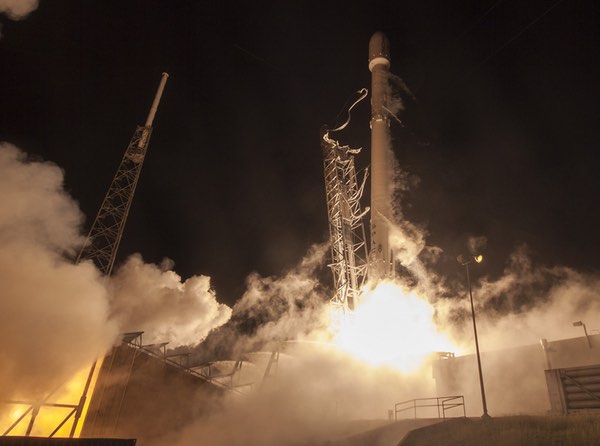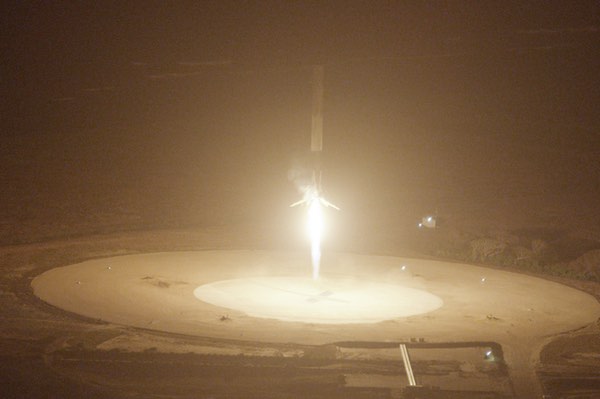A step towards reusabilityby Jeff Foust
|
| “First I thought, ‘Well, you know, at least we got close,’ but then I went back into launch control and saw the amazing video of the rocket touching down.” |
Musk might have been the last person watching the launch to find out the landing was successful. Most others were following along on SpaceX’s webcast, which broke away from the second stage’s ascent to orbit to follow the final seconds of the first stage’s approach to the landing pad. A crowd of hundreds at SpaceX’s Hawthorne, California, headquarters grew progressively louder as the stage descended under a single Merlin engine, targeting the center of the pad, marked with the swooping X from the company’s logo.
The stage itself was hard to see, lost in the glare of the rocket engine in the night sky. When the engine shut off, though, the video feed showed the stage standing upright, on or near that X. The stage had not crash landed, as it did on a January landing attempt on SpaceX’s floating landing pad in the Atlantic. It did not touch down and topple into the ocean, as it did on an April landing attempt.
“LZ-1,” said a voice from the launch control loop, heard on the webcast, “the Falcon has landed.” It was hard to hear anything else for the next couple of minutes, as the crowd in Hawthorne, and even the young SpaceX engineers serving as hosts of the webcast, erupted in cheers.
The cheering overlooked the fact that the mission itself was not yet over. The second stage was still firing, sending its payload of 11 ORBCOMM second-generation communications satellites into low Earth orbit. Fortunately for both SpaceX and ORBCOMM, the rest of the flight was anti-climactic: the 11 satellites separated from the upper stage as planned, and ORBCOMM later said all were in good health.
Even without the landing, the mission was a major success for SpaceX. The launch was the first for an upgraded version of the Falcon 9 (known simply as the “upgraded Falcon 9,” according to SpaceX.) This version of the vehicle has one-third greater performance than the version 1.1 variant, thanks in part to the use of “supercooled” liquid oxygen, chilled to near the freezing point to increase its density. It also features an improved stage separation system and a stretched upper stage to carry more propellant.
“I think it’s a significantly improved rocket from the last one,” Musk said during a December 15 talk at the Fall Meeting of the American Geophysical Union in San Francisco.
| “We could not have asked for a better mission,” Musk said. |
The last one, of course, was also a failure. The June 28 launch of a Falcon 9 v1.1 carrying a Dragon spacecraft ended in failure two and a half minutes after liftoff. That failure was linked to a strut holding down a helium bottle in the rocket’s upper stage that broke at a small fraction of its rated strength. That caused a propellant tank to overpressurize and burst, dooming the stage and the vehicle.
“That would have been a good day” if all the Falcon 9 did was get to orbit, Musk said. However, by all accounts the complete mission, including landing and satellite deployment, as well as a second burn of the upper stage to test it for future missions, all went as planned. “We could not have asked for a better mission,” he said.
 The upgraded Falcon 9, carrying 11 ORBCOMM satellites, lifts off from Cape Canaveral December 21. (credit: SpaceX) |
Although the return to flight and the successful launch of an upgraded version of the Falcon 9 were important, most people in the space community, and the general public, focused on the landing and its promise of reusability. For many, the landing heralded the beginning of a new age of reusable rocketry, with the promise of drastically lower launch costs. Musk, for example, has frequently talked about eventually reducing launch costs by a factor of 100 or more, down to essentially the cost of propellant.
However, don’t expect to launch satellites for $600,000 a flight instead of the current $60 million price of a Falcon 9 any time soon. Musk said that the stage that landed last month won’t fly again. Instead, SpaceX transported it to the new hangar it built at the base of Launch Complex 39A, the former Apollo- and shuttle-era launch pad that SpaceX is now leasing from NASA for Falcon Heavy and crewed Dragon missions.
Musk, in a tweet on New Year’s Eve, said inspections of the stage revealed no damage, and that it was “ready to fire again.” Some people interpreted that to mean the stage would fly again, but it’s more likely that Musk was referring to earlier plans to do static tests of the first stage at LC-39A.
“We’ll do a static fire on the launch pad there, to confirm that all systems are good and that we’re able to do a full-thrust hold-down firing of the rocket,” Musk said in the post-launch conference call. “We’ll probably keep this one on the ground, because it’s kind of unique. It’s the first one that we’ve brought back.”
A true test of reusability—flying the stage on a second mission—will come at some point later this year, depending on the tests performed on this stage and SpaceX’s ability to land stages on later missions. Musk said SpaceX has “well over a dozen” launches planned for 2016, giving the company plenty of opportunities to both recover another first stage and find a customer willing to fly on a reused rocket. Some time in 2016, he said, “we would aim to refly one of the rocket boosters.”
SpaceX hasn’t disclosed when it would attempt another landing. The next Falcon 9 mission is currently scheduled for January 17, carrying the Jason-3 satellite for NOAA. That launch, though, will be from Vandenberg Air Force Base in California, and will also be the final mission for the older 1.1 version of the Falcon 9. The next upgraded Falcon 9 launch will likely be in late January from Cape Canaveral, carrying the SES-9 communications satellite for SES.
| Without providing details about future missions, Musk sounded confident that SpaceX would soon have no shortage of recovered boosters ready to refly. “I imagine we’ll have a whole fleet of booster rockets accumulating quite rapidly,” he said. |
In the past, SpaceX has refrained from doing reusability tests on some missions, particularly those carrying communications satellites to geostationary orbit, because of the performance requirements of those missions. The upgraded version has improved performance, but it’s not clear if that will be enough to allow the Falcon 9 to perform a first stage landing—on land or at sea—for all its upcoming missions.
Musk noted in a blog post written just before the December 21 launch that the first stage of the upgraded Falcon 9 can accelerate 125 metric tons—the second stage and payload—to 8,000 kilometers per hour for first stage landings at sea but only 5,000 kilometers per hour for landings back on land, because of the additional maneuvers needed to turn the first stage around and head back to the launch site. That difference in velocity translates into payload performance for the upper stage.
Without providing details about future missions, Musk sounded confident that SpaceX would soon have no shortage of recovered boosters ready to refly. “I imagine we’ll have a whole fleet of booster rockets accumulating quite rapidly,” he said. He was also confident that the recovered stages could be reflown without major maintenance: he said the Merlin engines were fired 10 to 15 times, including both acceptance tests and the actual mission, with no sign of degradation.
It will take SpaceX some time, Musk acknowledged, to figure out just how to effectively refurbish and reuse those stages to provide the cost savings that reusability promises. “It’ll take us a few years to iron that all out and make sure it all works well,” he said.
There was, though, no denying at least the potential for sweeping change in space access that the successful landing could make possible, if recovered stages can be readily and effectively reflown. “It’s a revolutionary moment,” Musk said of the landing. “It’s a fundamental step change in technology compared to any other rocket that has ever flown.”
